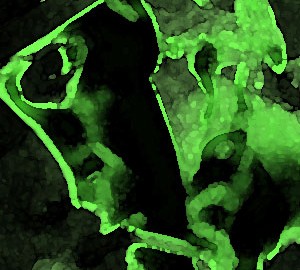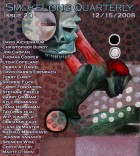What can you tell us about the writing of “The Head Fields”? Did it surprise you when you wrote it? It feels like it arose out of a deep, unconscious place…
“The Head Fields” was originally composed in response to a prompt from Ursula LeGuin to write a story based on a dream or dream fragment. At the time, I was taking a week-long workshop with LeGuin called “Following Darkness,” which focused on tapping the unconscious. We were assigned a story a day. The workshop was held at a retreat center in the Oregon Cascades. I had a bunk in the group-quarters which at night was filled with rows and rows of sleeping dreamers beside a floor-to-ceiling uncurtained window, I would like awake sometimes, staring up at the towering hemlocks and the vast field of stars. It felt a little like the ancient Greek dream-oracle, minus the attending priests and priestesses, and provided the setting for a week of intense writing and dreaming.
What do the interviewers represent too the main character? Are they archetypal? If so, how?
The psychologist Carl Jung believed that archetypal dreams are rare, but that they come to us in times of pivotal change in our lives, and that interpreting such dreams can provide us with answers to questions about how to navigate those changes. Interpreting the narrative as whole, I suspect it may be about losing one’s way, losing one’s inner compass, so to speak, perhaps losing sight of what one’s true career might be, which is always the discovery of self.
In the months leading up to the workshop, I had undergone an intense spring semester of job interviews for teaching positions in various colleges. The interviewers must have come out of the anxiety I still carried from that experience. The fact that they come whirling out of the head fields to the east may be a playful, unconscious pun on the field of education, my chosen career; their personalities were more consciously drawn from those of my male colleagues at the community college where I teach.
When I use this dream-narrative with my own students (part of a basic composition course called “Dreams and Inward Journeys” that includes an introduction to archetypes and dream analysis) they are quick to identify the interviewers as the positive and negative animus: the dreamer’s soul-guide and inner judge/saboteur. So I think it would be fair to say the interviewers may be parts of the narrator’s own psyche projected onto the stage of the narrative.
I envision a surrealist painting when reading this piece. The head fields, the tuning fork… Do dreams influence your writing? How?
I think of dreams as my native language, and as a writer, I often tap my dreams. But more often when I write, I am trying to access a semi-trancelike state in which I am writing without much conscious direction. In her novel The Lathe of Heaven, LeGuin’s protagonist, George Orr, describes dream-thought as “nonconscious thinking”; noveist Stephen King, poet William Stafford, and many others have described this as “dreaming awake.” In King’s essay, “The Symbolic Language of Dreams,” he says that when he is working in this state, “I feel like the tail on a kite. I don’t feel like the kite itself, or like the wind that blows on the kite—I’m just the tail of it.” King also says that dreams are like the mirrors we use to see the back of our heads. We can’t see this part of ourselves directly; only by looking away in the mirror held at an angle can we access these hidden parts of ourselves.
I think it is wise to let go the reins of conscious intention when we are in the early stages of writing because the unconscious mind is better at creating, while the conscious mind is much better at editing. At least that’s been my experience.
Talk about the tuning fork specifically if you will, and its intriguing relationship to the main character…
I don’t have a simple symbolic explanation for the tuning fork, though I accept my students’ assessment that it is a key—a dream symbol representing access to deeper parts of the self, perhaps a phallic symbol in the most general sense of a “tool of power.”
I’ve come to see that “The Head Fields” is saturated with images of waves and vibrations: and the tuning fork may be related to that. As a tool, it creates a pure vibration, used to set other instruments in tune. The gift of the tuning fork from one of the interviewers suggests the ability to put oneself in tune, just as its loss of the tuning fork in the end signifies the unfinished struggle to find this inner balance.
The waves or vibrations may also represent the deep rhythms of poetic impulse. At the time I had the dream, I suspect my unconscious was sending me a message that I had lost touch with my own source of creative inspiration, perhaps as a result of pursuing a teaching career at the expense of my writing. I needed to put those parts of myself in better balance.
Congratulations on your latest book of poetry, Translations From the Human Language. What’s next for Terry Ehret?
As always,I will continue to be the tail of the kite and see where the creative winds may take me. Although most of my publishing has been poetry, I have devoted the last twelve years to learning the craft of narrative. My work with LeGuin and author Grace Paley has been part of the pursuit. I’d like to develop my skills in personal essay and fictional narrative.
As far as publishing, my three previous publications all include a generous number of prose-poems and tiny stories, along with lyric poems. I’d like to compile a manuscript of new and selected prose that would include prose-poems, dream tales, and fables. I also have a long-suffering novel (don’t we all?), based on the Trojan War. With time, I hope to finish that project and find a publisher for it.
Thanks so much for the invitation to answer these questions.



 The core workshop of SmokeLong Fitness is all in writing, so you can take part from anywhere at anytime. We are excited about creating a supportive, consistent and structured environment for flash writers to work on their craft in a community. We are thrilled and proud to say that our workshop participants have won, placed, or been listed in every major flash competition. Community works.
The core workshop of SmokeLong Fitness is all in writing, so you can take part from anywhere at anytime. We are excited about creating a supportive, consistent and structured environment for flash writers to work on their craft in a community. We are thrilled and proud to say that our workshop participants have won, placed, or been listed in every major flash competition. Community works.